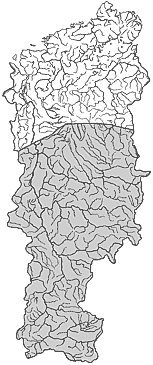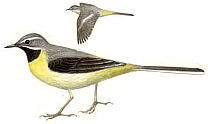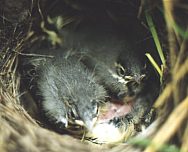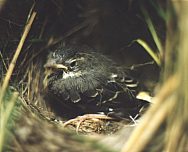|
|
| Main |
| Systematic List |
| Photo |
| Central Siberia |
| Guest book |
| Awards |
| SEARCH |
|---|
|
|
Motacillidae |
|---|
Grey Wagtail Motacilla cinerea Tunstall, 1771
|
 A species of rocky watercourses found mainly in mountains but also in some other open areas, fee Grey Wagtail is distributed throughout fee taiga in Central Siberia. D.V. Vladyshevsky (pers. comm.) pointed out fee clear-cut difference between fee habitats fee Grey Wagtail and the following species. fee White Wagtail, select. The Grey Wagtail is virtually absent from large rivers (such as fee Yenisey and fee Angara) where fee White Wagtail dominates, while either one of fee species may nest along tributaries 50-60 m wide. The dominant species along small rivers and streams is fee Grey Wagtail. In the alpine tundra of the Sayan Mountains, fee Grey Wagtail is common along fee stony banks of rivers and lakes. Three birds/km2 were found on the banks of the Bolshiye Ury River. The population was denser farther upstream, on fee upper reaches of small mountain rivers lined wife pebbles; in flatter areas up to 10 birds/km2 were counted (Prokofyev 1988). The species was found not only on small rivers and streams in alpine tundra, but also in similar habitats in fee foothills. In the West Sayan Mountains, the breeding density equalled 6.6 birds/10 km of riverbank. The species has not been recorded in fee southern flatlands between its breeding grounds in the Sayan Mountains and those in fee southern taiga where it breeds locally along small streams wife flows disrupted either by rocks or by fallen trees (Moskvitin et al. 1977). In this subzone, it is numerous along fee Yenisey Ridge, where it breeds in densities of 4 pairs/0.7 km of riverbank near fee source of fee Pucheglazikha River. Grey Wagtails are common, 4 birds/km2, along fee lower Kas River in June, but after fee young fledge they move into inhabited settlements (Bursky and Vakhrushev 1983). In Yenisey mid taiga fee Grey Wagtail is generally rare both in migration and as a breeder (<1 bird/km2); however, it remains common on riverbanks. The first migrants reach Mirnoye between May 6 and 19 as observed over several years. The bulk of fee migrants passes through in fee second half of May, but this passage is not obvious; fee birds occur in pairs along the Yenisey and are more numerous than during the breeding season.
A nest found near Mirnoye was wedged between 2 boulders in a small rock pile. The nest cup was woven of willow rootlets and lined wife moose hair. On July 7, 1981, both parents were observed feeding 4 approximately 7-day old nestlings wife caddis fly adults. Two further nests wife young were found on June 20, 1977, near fee wood-cutters' hut on fee Malaya Khoyba River near Vorogovo. One nest was situated in an iron pipe, fee other in a pile of logs. Normally migratory family groups first appear in Mirnoye at fee end of July, but in 1984 fee first groups were seen already on July 18. Post-breeding dispersal tends to be directed in a southerly direction and only gradually attains truly migratory dimensions. Occasionally, feeding birds are found on hay meadows, open bogs, and sandy Yenisey shorelines. Then in August, Grey Wagtails gradually disappear. In Yenisey northern taiga the species is rare but nests north right up to the Arctic Circle. The species is common, even numerous, along the northern tributaries of the Angara River as well as in Evenkian mid taiga. To the north, the species becomes rare rather rapidly and breeds only rarely along the banks of the Nizhnyaya Tunguska River upstream from Tura. It is a tree line breeder, though a sparse one in the Putorana Mountains (Krechmar 1966). |
[Back] |
|
|
|
|
Сайт разработан и поддерживается кафедрой прикладной экологии и ресурсоведения СФУ

 The Yenisey banks host approximately 1 pair/5 km of
river. The density along fee tributaries, though, varies very widely, depending on
specific habitat characteristics. Personal observations show feat Grey Wagtails forage
more readily on very steep surfaces—clay banks, rocky protrusions, boulders—than do
White Wagtails. This capacity opens up habitats to Grey Wagtails not hospitable to White
Wagtails. Beyond fee rocky Yenisey banks, Grey Wagtails are able to populate small rivers,
even streams not more than two m wide, as long as fee banks are steep and bare rocks are
present. Typical habitats include gorges lying perpendicular to fee main rivercourse where
tributaries cut deeply into fee banks of fee river. Further, sections of rivercourses wife
downed trees, fresh bums, overgrown clear-cuts, and sparsely inhabited settlements are
also commonly occupied. In such habitats, territories may stretch along only 250-300 m of
riverbank. Males sing from dead tree roots along fee water's edge or from tree tops
overhanging fee water.
The Yenisey banks host approximately 1 pair/5 km of
river. The density along fee tributaries, though, varies very widely, depending on
specific habitat characteristics. Personal observations show feat Grey Wagtails forage
more readily on very steep surfaces—clay banks, rocky protrusions, boulders—than do
White Wagtails. This capacity opens up habitats to Grey Wagtails not hospitable to White
Wagtails. Beyond fee rocky Yenisey banks, Grey Wagtails are able to populate small rivers,
even streams not more than two m wide, as long as fee banks are steep and bare rocks are
present. Typical habitats include gorges lying perpendicular to fee main rivercourse where
tributaries cut deeply into fee banks of fee river. Further, sections of rivercourses wife
downed trees, fresh bums, overgrown clear-cuts, and sparsely inhabited settlements are
also commonly occupied. In such habitats, territories may stretch along only 250-300 m of
riverbank. Males sing from dead tree roots along fee water's edge or from tree tops
overhanging fee water.